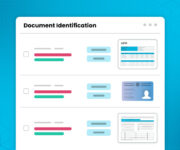The use of fake document remains a key source of financial fraud across India. In the fiscal year 2023, the Reserve Bank of India (RBI) reported bank frauds exceeding ₹21,367 crore, highlighting the significant impact of fraudulent activities on the financial sector.
The increasing reliance on digital platforms for customer onboarding has made it easier for fraudsters to exploit vulnerabilities by submitting forged documents, thereby complicating the detection and prevention of such fraud.
Financial institutions, especially banks and Non-Banking Financial Companies (NBFCs), are particularly susceptible due to the extensive range of services they offer online. To combat this growing threat, it is imperative for these institutions to implement advanced verification technologies and robust fraud detection systems.
This blog post discusses effective strategies to identify fake documents and enhance fraud prevention measures.
Prevent Frauds: How to Identify Fake Documents Rapidly
To counter fake documents, financial institutions are now investing in smarter technologies during the KYC and onboarding stages. Here are important tips to detect and prevent document fraud:
1. Use Microscopic Scanners for Texture Analysis
Using microscopic scanners for texture and data inconsistency analysis will help identify forged documents and stolen documents on the black market.
Forged Documents
Fraudsters often manipulate genuine documents by making deliberate alterations. These can range from basic edits, such as changing the date of birth or expiry date, to more sophisticated tampering, like rewriting the full address, inserting forged watermarks, or even embedding authentic pages taken from other original documents.
To carry out these alterations, fraudsters often use specialised tools or scrubbers to erase original content and overwrite it with false information.
Critical details may be added or deleted in property documents or legal agreements. Additions are usually inserted towards the end of the document where blank space is available, often in the form of extra clauses that benefit the document holder.
Conversely, removals typically use chemical whiteners, allowing edits anywhere in the document.
Detecting such tampering requires advanced microscopic scanners to analyze texture and ink density. These tools can reveal inconsistencies in font structure or printing patterns, clearly indicating that the document has been manipulated.
Bank-Stolen Documents
All original documents begin as blank templates before being personalised. Fraudsters exploit this by infiltrating the document supply chain, obtaining blank originals, and filling them with fabricated information. These operations often involve coordinated networks and are difficult to detect at first glance.
However, even the most convincing fake document cannot replicate every security element. Unique features such as watermarks, stamps, and microtext are difficult to forge with precision. Fraudsters have even managed to produce counterfeit bank statements using this method.
Advanced microscopic scanners can help flag fraud by detecting text, texture, or placement inconsistencies. The document can be escalated for deeper verification once anomalies are identified, such as irregular positioning of key details like date of birth, expiry, or issue date.
2. Use Advanced Visual Authentication Techniques
Advanced visual authentication techniques, such as scanning specific security features, stamps, and watermarks, will help identify counterfeit, compromised, or sample documents and camouflaged documents.
Counterfeiting Original Identity
While modified documents involve altering real ones, fake documents are often entirely fabricated from scratch. Identity counterfeiting remains one of the most common forms of document fraud.
Here, fraudsters replicate the template of an authentic ID and insert false personal details to create a near-identical copy. At first glance, these forgeries may appear genuine—but a closer inspection often reveals the absence of key security features unique to legitimate documents.
This type of fraud typically occurs during the KYC stage of customer onboarding. Instead of speeding through verification, onboarding systems should be equipped to scan for specific visual markers—such as holograms, microtext, or embedded codes—that can quickly expose the document as counterfeit.
Compromised or Sample Documents Misused
Fraudsters often misuse government-issued IDs and legal documents sourced from public domains such as online presentations, sample repositories, or unsecured websites. By inserting personalised details into these samples, they attempt to pass them off as original documents.
Visual document authentication techniques can help uncover such fraud by detecting subtle anomalies, like inconsistencies in font style, altered ID photos, or pixel-level tampering. These tools are especially effective when cross-referencing against expected security features embedded in authentic documents.
Camouflage Documents/ Fantasy Documents
Camouflaged or fantasy documents often include fictitious or misspelt place names—such as “Utopia” or “Griece”—to falsely represent issuing authorities. These subtle manipulations are designed to mimic legitimate entries and can easily be overlooked during manual checks.
Advanced visual authentication tools can help flag such discrepancies by validating place names and countries, and issuing authorities against authorised databases. This cross-verification is crucial for detecting fake documents that rely on linguistic trickery to appear credible.
3. Live Identity Verification
Live identity verification techniques, such as selfie photos or live video chat, will help prevent fraud by using fraudulently obtained documents and impostor documents.
Fraudulently-Obtained Document
This is a tricky category in which the fraudsters use somebody else’s stolen photo and use it in their original document. Verifying this kind of fraud requires utilising proof of ownership techniques, such as having the document holder capture a live photo using the verification device and comparing it with the photo in the document.
Imposter Document
This type of fake document fraud involves impersonation, where a fraudster uses someone else’s genuine identity document as their own. If the KYC process lacks robust safeguards, such imposters can easily bypass verification.
A reliable way to prevent this is through live identity checks. By initiating a live video interaction and capturing a real-time image of the applicant, institutions can compare it directly with the photo on the submitted document, helping to confirm authenticity and ownership.
Final Note
As fraud via fake documents becomes more advanced and widespread, especially in digital-first onboarding processes, financial institutions can no longer rely on basic verification methods. From forged property agreements to impersonated IDs, the risks are varied—but so are the solutions.
By adopting microscopic scanners, advanced visual authentication tools, and live identity verification techniques, banks and NBFCs can detect and deter fraud at the earliest stage. These technologies not only strengthen compliance but also protect the institution’s bottom line and customer trust.
Finezza’s lending and onboarding solutions are designed to help you stay ahead of evolving fraud tactics. With capabilities like document validation, automated data extraction, and real-time analytics, our platform ensures faster, safer, and smarter decision-making.
Get in touch with us to streamline your verification process and stay protected against document fraud.




Leave a Reply